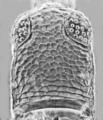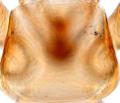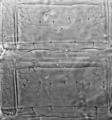Aptinothrips rufus
Recognition data
Distinguishing features
Both sexes without wings. Body and legs yellow, antennal segment VI shaded brown. Antennae 6-segmented; segment VI pedicilate, twice as long as V and tapering to apex; segments III–IV with sensorium simple. Head and pronotum without long setae; head longer than wide, ocelli not developed. Meso & metanota transverse. Tarsi each with only one segment. Abdominal tergites and sternites with no posteromarginal craspedum; tergal discal setae varying from 2–20; tergite IX posteromedian setae short, about 0.2 times as long as lateral pair of setae; sternites with many discal setae.
Male similar but smaller; sternites without pore plates; tergite IX with 2 pairs of stout thorn-like setae.
Variation
Adults in populations growing on halophytic plants around salt marshes are commonly brown rather than yellow, but this is assumed to have an environmental rather than a genetic basis.
Related and similar species
Four species are recognized in this European genus (Palmer, 1975; zur Strassen, 2003). These are all completely wingless, but differ in the number of antennal and tarsal segments, and also in details of the chaetotaxy on the tergites and sternites. Two of the species are known only from Eurasia, but both A. rufus and A. stylifer are more widely distributed around the world. A. stylifer has the antennae 8-segmented and the tarsi 2-segmented.
Taxonomic data
Current valid name
Aptinothrips rufus Haliday
Original name and synonyms
- Thrips (Aptinothrips) rufus Haliday, 1836: 445
- Thrips (Aptinothrips) nitidulus Haliday, 1836: 446
- Aptinothrips connaticornis Uzel, 1895: 153
- Aptinothrips intermedius Priesner, 1920: 52
- Aptinothrips groenlandica Richter, 1928: 850
- Uzeliella lubbocki Bagnall, 1908: 5
Family placement
Thripidae, Thripinae
Biological data
Life history
Feeding and breeding on leaves.
Host plants
Breeding on several species of grasses (Poaceae), but there have been no studies on the host specificity.
Tospoviruses vectored
None
Crop damage
Sometimes in high populations on grasses and cereal crops.
Distribution data
Area of origin
Europe
Distribution
Widespread around the world in temperate areas, including mountains in some tropical countries.









